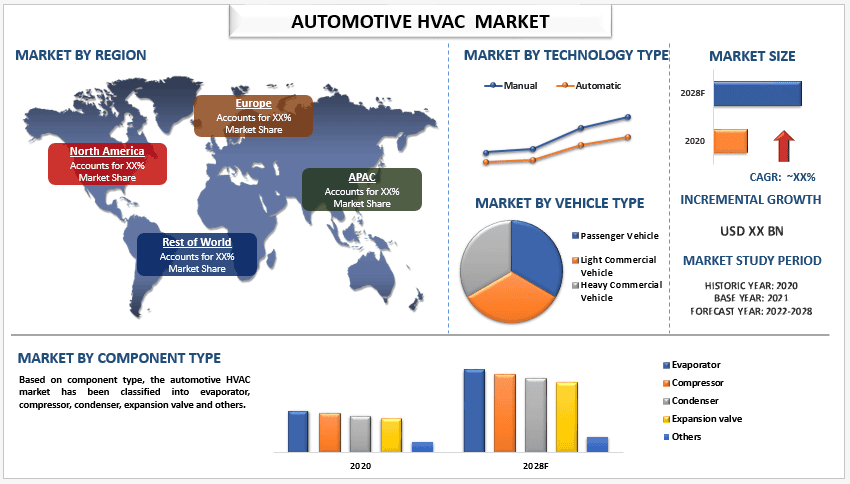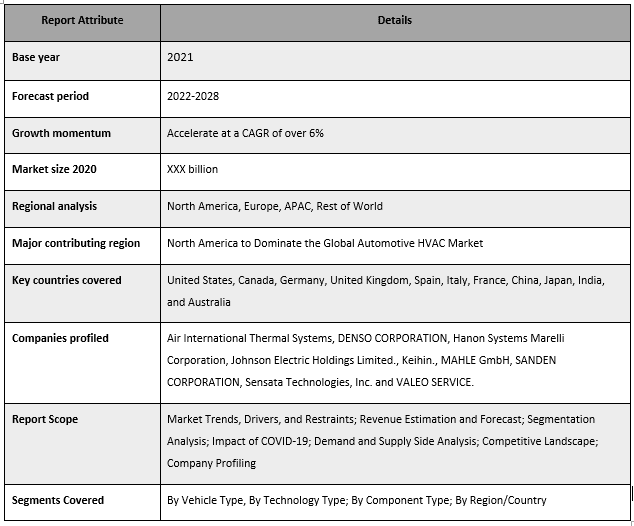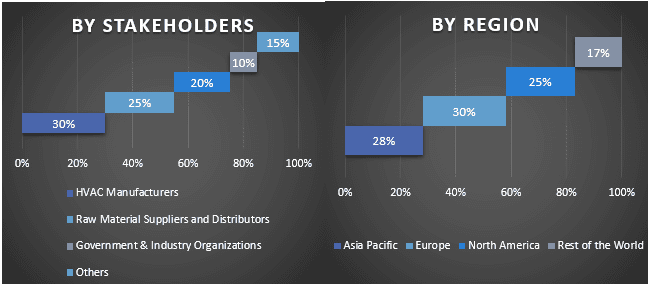- الرئيسية
- معلومات عنا
- صناعة
- الخدمات
- قراءة
- اتصل بنا
سوق تكييف الهواء في السيارات: التحليل والتوقعات الحالية (2022-2028)
التركيز على نوع التكنولوجيا (يدوي وأوتوماتيكي)؛ نوع السيارة (سيارات الركاب، والمركبات التجارية الخفيفة، والمركبات التجارية الثقيلة)؛ نوع المكون (المبخر، الضاغط، المكثف، صمام التمدد وغيرها)؛ والمنطقة/البلد

من المتوقع أن ينمو سوق تكييف الهواء العالمي للسيارات بمعدل كبير يبلغ حوالي 6٪ خلال الفترة المتوقعة 2022-2028.من المتوقع أن ينمو سوق تكييف الهواء العالمي للسيارات (التدفئة والتهوية وتكييف الهواء) في السنوات القادمة بسبب زيادة الطلب على راحة الركاب والحاجة إلى تلبية معايير الانبعاثات التنظيمية. يعتبر نظام تكييف الهواء مكونًا أساسيًا في أي مركبة وهو مسؤول عن الحفاظ على درجة الحرارة المطلوبة داخل المقصورة. مدفوعًا بنمو السوق عن طريق زيادة إنتاج المركبات والتقدم في التكنولوجيا وارتفاع طلب المستهلكين على السيارات الفاخرة والراقية. كما أدى ظهور السيارات الكهربائية إلى تطوير أنظمة تكييف هواء مبتكرة، وهي أكثر كفاءة في استخدام الطاقة وصديقة للبيئة. بشكل عام، من المتوقع أن ينمو سوق تكييف الهواء العالمي للسيارات في السنوات القادمة بسبب زيادة الطلب على ميزات الراحة والسلامة في المركبات، بالإضافة إلى الحاجة إلى تلبية لوائح الانبعاثات.
Air International Thermal Systems و DENSO CORPORATION و Hanon Systems Marelli Corporation و Johnson Electric Holdings Limited. و Keihin. و MAHLE GmbH و SANDEN CORPORATION و Sensata Technologies, Inc. و VALEO SERVICE هم بعض اللاعبين الرئيسيين في السوق. تم تنفيذ العديد من عمليات الاندماج والاستحواذ بالإضافة إلى الشراكات من قبل هؤلاء اللاعبين لتزويد العملاء بمنتجات/تقنيات مبتكرة وعالية التقنية.
رؤى معروضة في التقرير
“من بين أنواع التكنولوجيا، من المتوقع أن تشهد الفئة الأوتوماتيكية معدل نمو سنوي مركب أعلى خلال الفترة المتوقعة”
بناءً على النوع، يتم تقسيم السوق إلى أوتوماتيكي ويدوي. من المرجح أن يكون معدل نمو الفئة الأوتوماتيكية في سوق تكييف الهواء للسيارات أعلى لأن أنظمة تكييف الهواء الأوتوماتيكية توفر تحكمًا مريحًا في درجة الحرارة، مما يجعل تجربة القيادة أكثر راحة للسائقين والركاب. بالإضافة إلى ذلك، أصبحت أنظمة تكييف الهواء المؤتمتة أكثر تقدمًا، مع ميزات مثل التحكم في المناخ والتعديل التلقائي لدرجة الحرارة والإعدادات القابلة للبرمجة. أدت هذه التطورات إلى زيادة شعبية الفئة الأوتوماتيكية. علاوة على ذلك، فإن الأنظمة الآلية أكثر كفاءة في استخدام الطاقة، مما يدفع نموها في السوق. تساهم الزيادة في الطلب على السيارات الكهربائية (EVs) أيضًا في نمو الفئة الأوتوماتيكية في سوق تكييف الهواء في السيارات.
“من بين أنواع المركبات، من المتوقع أن تحتفظ المركبات التجارية بحصة كبيرة في السوق في عام 2020”
على أساس نوع السيارة، يتم تقسيم السوق إلى سيارات ركاب، ومركبات تجارية خفيفة، ومركبات تجارية ثقيلة. من بين هؤلاء، عادة ما يكون للفئة الفرعية للمركبات التجارية الثقيلة معدل نمو أعلى في سوق تكييف الهواء في السيارات. شهدت صناعة تكييف الهواء في السيارات تقدمًا تكنولوجيًا كبيرًا في السنوات الأخيرة، مما أدى إلى تطوير أنظمة تكييف هواء أكثر كفاءة وصغيرة الحجم يمكن تركيبها بسهولة في المركبات التجارية الثقيلة. بالإضافة إلى ذلك، أدت صناعة التجارة الإلكترونية والخدمات اللوجستية المتنامية إلى زيادة الطلب على المركبات التجارية الثقيلة، مما أدى بدوره إلى نمو سوق تكييف الهواء في السيارات.
“من المتوقع أن تحتفظ أمريكا الشمالية بحصة كبيرة في السوق”
تمتلك أمريكا الشمالية حصة كبيرة من سوق تكييف الهواء العالمي للسيارات لعدة أسباب، والتي تشمل أن هذه المنطقة موطن لبعض من أكبر مصنعي السيارات في العالم، مثل جنرال موتورز وفورد وتسلا، مما يؤدي إلى زيادة الطلب على أنظمة تكييف الهواء في المنطقة. يتمتع المستهلكون في أمريكا الشمالية بقوة شرائية عالية، مما يسمح لهم بشراء مركبات متطورة مجهزة بأنظمة تكييف هواء متقدمة. بالإضافة إلى ذلك، تفرض دول أمريكا الشمالية، ولا سيما الولايات المتحدة، لوائح صارمة بشأن الانبعاثات شجعت على اعتماد أنظمة تكييف هواء متقدمة للتحكم في درجة حرارة مقصورة السيارة وتحسين كفاءة استهلاك الوقود. كانت المنطقة رائدة في تطوير تقنيات جديدة لأنظمة تكييف الهواء في السيارات، وهذا أدى إلى زيادة الطلب على هذه الأنظمة. ساهمت كل هذه العوامل في نمو سوق تكييف الهواء في السيارات في أمريكا الشمالية، مما جعلها لاعبًا مهمًا في السوق العالمية.
تغطية تقرير سوق تكييف الهواء في السيارات

أسباب شراء هذا التقرير:
- تتضمن الدراسة تحديد حجم السوق وتحليل التنبؤات التي تم التحقق منها بواسطة خبراء الصناعة الرئيسيين المعتمدين.
- يقدم التقرير مراجعة سريعة للأداء العام للصناعة في لمحة.
- يغطي التقرير تحليلًا متعمقًا لشركاء الصناعة البارزين مع التركيز الأساسي على البيانات المالية التجارية الرئيسية ومحفظة المنتجات واستراتيجيات التوسع والتطورات الأخيرة.
- فحص مفصل للدوافع والقيود والاتجاهات الرئيسية والفرص السائدة في الصناعة.
- تغطي الدراسة السوق بشكل شامل عبر شرائح مختلفة.
- تحليل متعمق على المستوى الإقليمي للصناعة.
خيارات التخصيص:
يمكن تخصيص سوق تكييف الهواء العالمي للسيارات بشكل أكبر وفقًا للمتطلبات أو أي شريحة سوق أخرى. إلى جانب ذلك، تدرك UMI أن لديك احتياجات عملك الخاصة، ومن ثم لا تتردد في الاتصال بنا للحصول على تقرير يناسب متطلباتك تمامًا.
جدول المحتويات
منهجية البحث لتحليل سوق تكييف الهواء في السيارات (2022-2028)
كان تحليل السوق التاريخي وتقدير السوق الحالي والتنبؤ بالسوق المستقبلي لسوق تكييف الهواء العالمي للسيارات هي الخطوات الثلاث الرئيسية التي تم اتخاذها لإنشاء وتحليل اعتماد تكييف الهواء في السيارات في المناطق الرئيسية على مستوى العالم. تم إجراء بحث ثانوي شامل لجمع أرقام السوق التاريخية وتقدير حجم السوق الحالي. ثانيًا، للتحقق من صحة هذه الرؤى، تم أخذ العديد من النتائج والافتراضات في الاعتبار. علاوة على ذلك، تم إجراء مقابلات أولية شاملة أيضًا مع خبراء الصناعة عبر سلسلة القيمة لسوق تكييف الهواء العالمي للسيارات. بعد افتراض وصحة أرقام السوق من خلال المقابلات الأولية، استخدمنا نهجًا من أعلى إلى أسفل/من أسفل إلى أعلى للتنبؤ بحجم السوق الكامل. بعد ذلك، تم اعتماد طرق تقسيم السوق وتثليث البيانات لتقدير وتحليل حجم السوق لقطاعات وشرائح فرعية من الصناعة. يتم شرح المنهجية التفصيلية أدناه:
تحليل حجم السوق التاريخي
الخطوة 1: دراسة متعمقة للمصادر الثانوية:
تم إجراء دراسة ثانوية تفصيلية للحصول على حجم السوق التاريخي لسوق تكييف الهواء في السيارات من خلال مصادر الشركة الداخلية مثلالتقارير السنوية والبيانات المالية وعروض الأداء والبيانات الصحفية وما إلى ذلك،والمصادر الخارجية بما في ذلكالمجلات والأخبار والمقالات والمنشورات الحكومية ومنشورات المنافسين وتقارير القطاعات وقاعدة بيانات الجهات الخارجية والمنشورات الأخرى ذات المصداقية.
الخطوة 2: تقسيم السوق:
بعد الحصول على حجم السوق التاريخي لسوق تكييف الهواء في السيارات، أجرينا تحليلًا ثانويًا تفصيليًا لجمع رؤى وحصص السوق التاريخية لشرائح وشرائح فرعية مختلفة للمناطق الرئيسية. يتم تضمين الشرائح الرئيسية في التقرير كنوع التكنولوجيا ونوع السيارة ونوع المكون. علاوة على ذلك، تم إجراء تحليلات على مستوى الدولة لتقييم الاعتماد العام لنماذج الاختبار في تلك المنطقة.
الخطوة 3: تحليل العوامل:
بعد الحصول على حجم السوق التاريخي لشرائح وشرائح فرعية مختلفة، أجرينا تفصيليًاتحليل العوامللتقدير حجم السوق الحالي لسوق تكييف الهواء في السيارات. علاوة على ذلك، أجرينا تحليلًا للعوامل باستخدام متغيرات تابعة ومستقلة مثل أنواع التكنولوجيا المختلفة ونوع السيارة ونوع المكونات الخاصة بتكييف الهواء في السيارات. تم إجراء تحليل شامل لسيناريوهات العرض والطلب مع الأخذ في الاعتبار الشراكات والاندماجات والاستحواذات وتوسيع الأعمال وإطلاق المنتجات في قطاع سوق تكييف الهواء في السيارات في جميع أنحاء العالم.
تقدير وتوقع حجم السوق الحالي
تحديد حجم السوق الحالي:بناءً على رؤى قابلة للتنفيذ من الخطوات الثلاث المذكورة أعلاه، توصلنا إلى حجم السوق الحالي واللاعبين الرئيسيين في سوق تكييف الهواء العالمي للسيارات وحصص السوق للقطاعات. تم تحديد جميع حصص النسب المئوية المطلوبة والتقسيمات وتحليل السوق باستخدام النهج الثانوي المذكور أعلاه وتم التحقق منها من خلال المقابلات الأولية.
التقدير والتنبؤ:لتقدير السوق والتنبؤ به، تم تخصيص أوزان لعوامل مختلفة بما في ذلك المحركات والاتجاهات والقيود والفرص المتاحة لأصحاب المصلحة. بعد تحليل هذه العوامل، تم تطبيق تقنيات التنبؤ ذات الصلة، أي نهج من أعلى إلى أسفل/من أسفل إلى أعلى، للتوصل إلى توقعات السوق لعام 2028 لشرائح وشرائح فرعية مختلفة عبر الأسواق الرئيسية على مستوى العالم. تشمل منهجية البحث المعتمدة لتقدير حجم السوق:
- حجم الصناعة من حيث الإيرادات (بالدولار الأمريكي) ومعدل اعتماد سوق تكييف الهواء في السيارات عبر الأسواق الرئيسية محليًا
- جميع الحصص النسبية والتقسيمات والتحليلات التفصيلية لقطاعات السوق وشرائحه الفرعية
- اللاعبين الرئيسيين في سوق تكييف الهواء العالمي للسيارات من حيث المنتجات المعروضة. أيضًا، استراتيجيات النمو التي يتبناها هؤلاء اللاعبون للمنافسة في السوق سريعة النمو
التحقق من صحة حجم السوق وحصته
البحث الأولي:أُجريت مقابلات متعمقة مع قادة الرأي الرئيسيين (KOLs) بما في ذلك كبار المسؤولين التنفيذيين (CXO/VPs، رئيس المبيعات، رئيس التسويق، رئيس العمليات، الرئيس الإقليمي، رئيس الدولة، إلخ) عبر المناطق الرئيسية. ثم تم تلخيص نتائج البحث الأولي، وتم إجراء تحليل إحصائي لإثبات الفرضية المعلنة. تم دمج المدخلات من الأبحاث الأولية مع النتائج الثانوية، وبالتالي تحويل المعلومات إلى رؤى قابلة للتنفيذ.
تقسيم المشاركين الأوليين في مناطق مختلفة

هندسة السوق
تم توظيف تقنية تثليث البيانات لإكمال تقدير السوق الإجمالي والتوصل إلى أرقام إحصائية دقيقة لكل قطاع وشريحة فرعية من سوق التكييف والتدفئة والتهوية (HVAC) العالمي للسيارات. تم تقسيم البيانات إلى عدة شرائح وشرائح فرعية بعد دراسة المعايير والاتجاهات المختلفة في مجالات نوع التكنولوجيا ونوع السيارة ونوع المكون في سوق التكييف والتدفئة والتهوية (HVAC) العالمي للسيارات.
الهدف الرئيسي من دراسة سوق التكييف والتدفئة والتهوية (HVAC) العالمي للسيارات
تم تحديد اتجاهات السوق الحالية والمستقبلية لسوق التكييف والتدفئة والتهوية (HVAC) العالمي للسيارات في الدراسة. يمكن للمستثمرين الحصول على رؤى استراتيجية لبناء تقديراتهم للاستثمارات على التحليل النوعي والكمي الذي تم إجراؤه في الدراسة. حددت اتجاهات السوق الحالية والمستقبلية جاذبية السوق الإجمالية على المستوى الإقليمي، مما يوفر منصة للمشاركين الصناعيين لاستغلال السوق غير المستغلة للاستفادة من ميزة السبق. تشمل الأهداف الكمية الأخرى للدراسات:
- تحليل حجم السوق الحالي والمتوقع لسوق التكييف والتدفئة والتهوية (HVAC) للسيارات من حيث القيمة (دولار أمريكي). أيضًا، تحليل حجم السوق الحالي والمتوقع للقطاعات والشرائح الفرعية المختلفة
- تشمل القطاعات في الدراسة مجالات نوع التكنولوجيا ونوع السيارة ونوع المكون.
- تحديد وتحليل الإطار التنظيمي للتكييف والتدفئة والتهوية (HVAC) في صناعة السيارات
- تحليل سلسلة القيمة المتضمنة مع وجود العديد من الوسطاء، إلى جانب تحليل سلوكيات العملاء والمنافسين في الصناعة.
- تحليل حجم السوق الحالي والمتوقع لسوق التكييف والتدفئة والتهوية (HVAC) للسيارات للمنطقة الرئيسية.
- تشمل البلدان الرئيسية للمناطق التي تمت دراستها في التقرير آسيا والمحيط الهادئ وأوروبا وأمريكا الشمالية وبقية العالم.
- ملفات تعريف الشركات لسوق التكييف والتدفئة والتهوية (HVAC) للسيارات واستراتيجيات النمو التي يتبناها اللاعبون في السوق للبقاء في السوق سريع النمو
- تحليل متعمق على المستوى الإقليمي للصناعة
ذات صلة التقارير
العملاء الذين اشتروا هذا المنتج اشتروا أيضًا










